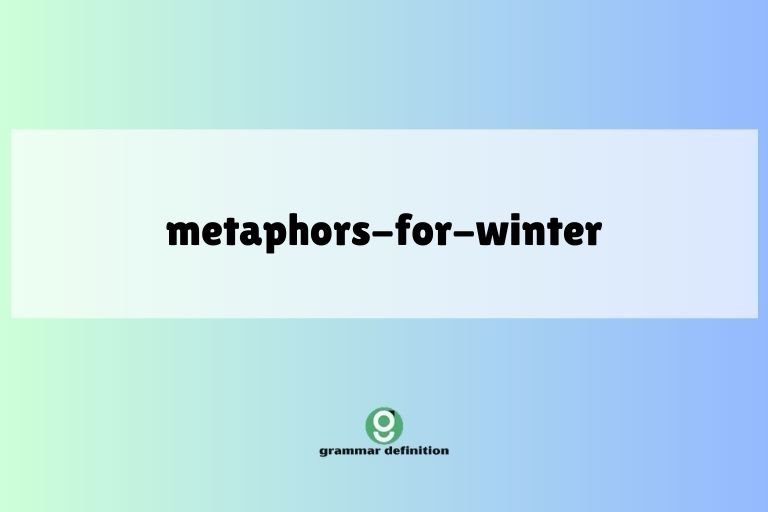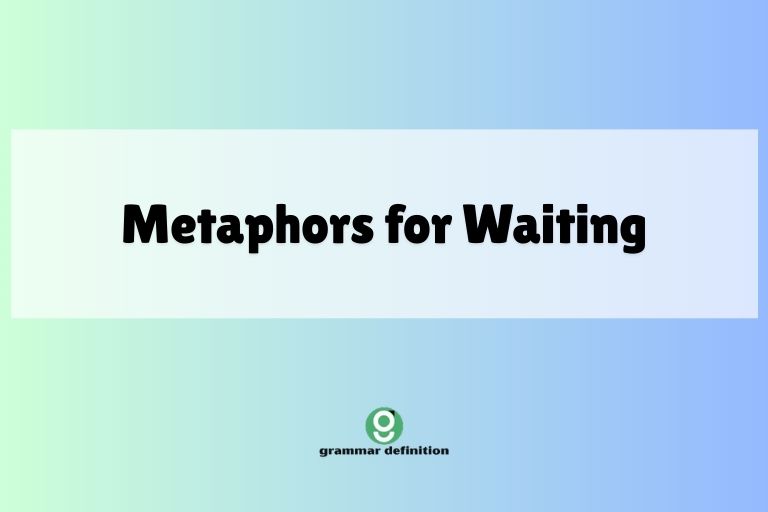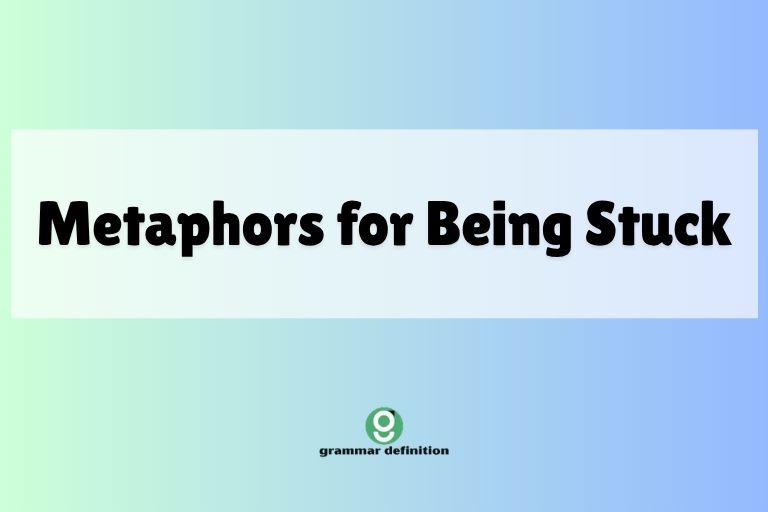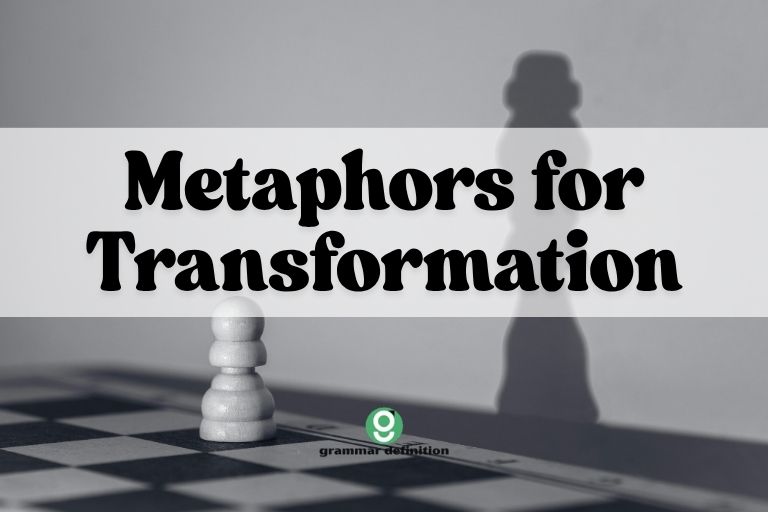Winter’s Whisper: Mastering Metaphors for the Coldest Season

Metaphors are powerful tools in the English language, allowing us to paint vivid pictures and convey complex emotions with just a few words. Understanding how to use and interpret metaphors is essential for both fluent communication and a deeper appreciation of literature and poetry.
This article delves into the realm of winter metaphors, exploring how the coldest season is often depicted through figurative language. By mastering these metaphors, you’ll enhance your writing skills, improve your reading comprehension, and gain a richer understanding of the English language.
This guide is designed for English language learners of all levels, from intermediate students looking to refine their expressive abilities to advanced speakers aiming to master nuanced figurative language.
Whether you’re a student preparing for an exam, a writer seeking to add depth to your prose, or simply an avid reader eager to unlock the hidden meanings within texts, this exploration of winter metaphors will equip you with the knowledge and skills you need to succeed. We will explore the definition of a metaphor, winter-related metaphors, their structural breakdown, examples, usage rules, common mistakes, practice exercises, advanced topics, and frequently asked questions.
Table of Contents
- Introduction
- What is a Metaphor?
- Structural Breakdown of Metaphors
- Types of Winter Metaphors
- Examples of Winter Metaphors
- Usage Rules for Winter Metaphors
- Common Mistakes with Winter Metaphors
- Practice Exercises
- Advanced Topics in Winter Metaphors
- Frequently Asked Questions (FAQ)
- Conclusion
What is a Metaphor?
A metaphor is a figure of speech that directly compares two unrelated things, asserting that one thing is another. Unlike similes, which use “like” or “as” to make a comparison, metaphors create a direct equivalence. This equivalence isn’t literal, but rather suggestive, inviting the reader or listener to understand the first thing in terms of the second. Metaphors are used to add color, depth, and a new perspective to language. They can simplify complex ideas, evoke strong emotions, and make writing more engaging and memorable.
The function of a metaphor extends beyond mere decoration. It serves as a powerful tool for understanding and communication.
By framing one concept in terms of another, metaphors can reveal hidden similarities, highlight specific aspects, and offer fresh insights. In essence, a metaphor allows us to see the world in a new light, expanding our understanding and fostering creativity.
In the context of winter, metaphors are frequently used to express the season’s characteristics, emotional impact, and symbolic significance. These metaphors can range from simple comparisons, such as “winter is a blanket of snow,” to more complex and abstract representations, like “winter is the soul’s hibernation.” The effectiveness of a winter metaphor lies in its ability to resonate with our experiences and associations with the season.
Structural Breakdown of Metaphors
Understanding the structure of a metaphor involves recognizing its two key components: the tenor and the vehicle. The tenor is the subject being described, while the vehicle is the object or concept used to describe the tenor. In the metaphor “Winter is an old wolf,” “winter” is the tenor (the subject) and “old wolf” is the vehicle (the image used to describe winter). The effectiveness of the metaphor depends on the shared characteristics between the tenor and the vehicle, allowing the reader to draw meaningful connections.
The relationship between the tenor and vehicle is crucial. The vehicle should illuminate a particular aspect of the tenor.
In our example, the “old wolf” vehicle suggests characteristics of winter such as coldness, harshness, and perhaps even a sense of danger or threat. The more resonant and appropriate the vehicle, the more effective the metaphor will be.
Furthermore, the context in which the metaphor is used plays a significant role in its interpretation. The surrounding words, phrases, and overall tone of the text can influence how the metaphor is understood.
For example, if the sentence continues with “Winter is an old wolf, prowling through the skeletal trees,” the metaphor is reinforced and deepened, further emphasizing the predatory nature of winter.
Types of Winter Metaphors
Winter metaphors can be broadly categorized based on the specific aspects of winter they emphasize and the emotional or symbolic connotations they convey. Here are some common types:
Winter as Death and Decay
This type of metaphor highlights the barrenness and lifelessness often associated with winter. It emphasizes the end of the growing season, the dormancy of nature, and the apparent absence of life.
Examples include “winter is nature’s graveyard” or “winter is a frozen shroud.” These metaphors often evoke feelings of sadness, loss, and the inevitable cycle of life and death.
Winter as Sleep and Hibernation
This metaphor focuses on the idea of rest, dormancy, and renewal. It suggests that winter is a time for nature to recharge and prepare for the coming spring.
Examples include “winter is the earth’s slumber” or “winter is a long, quiet dream.” These metaphors often convey a sense of peace, tranquility, and anticipation.
Winter as Purity and Renewal
This type of metaphor emphasizes the cleansing and restorative aspects of winter. The snow, often seen as a symbol of purity, covers the landscape, creating a blank canvas for new beginnings.
Examples include “winter is a fresh start” or “winter is a blanket of innocence.” These metaphors often evoke feelings of hope, optimism, and the potential for growth.
Winter as Hardship and Resilience
This metaphor highlights the challenges and difficulties associated with winter, such as cold, scarcity, and isolation. However, it also emphasizes the ability to endure and overcome these challenges.
Examples include “winter is a test of strength” or “winter is a crucible of character.” These metaphors often convey a sense of determination, perseverance, and the power of the human spirit.
Winter as Isolation and Introspection
This type of metaphor focuses on the inward turn that winter often inspires. The long nights, the quiet landscapes, and the reduced social activity can lead to a period of self-reflection and contemplation.
Examples include “winter is a time for the soul to wander” or “winter is a mirror reflecting our inner selves.” These metaphors often evoke feelings of solitude, introspection, and the search for meaning.
Examples of Winter Metaphors
Here are some examples of winter metaphors, categorized by the types discussed above. Each table provides a range of metaphors, showcasing their versatility and expressive power.
The following table presents metaphors that portray winter as a period of death and decay, highlighting its barren and lifeless aspects.
| Metaphor | Explanation |
|---|---|
| Winter is nature’s graveyard. | Implies that nature is dead or dormant during winter, like a graveyard. |
| Winter is a frozen shroud. | Suggests that winter covers the earth like a burial cloth, signifying death. |
| The trees are winter’s skeletal fingers. | Compares the bare branches of trees to bones, emphasizing their lifelessness. |
| Winter is the year’s final sigh. | Presents winter as the end of the year’s life cycle, like a final breath. |
| Snow is winter’s cold tears. | Associates snow with sadness and mourning, like tears. |
| The landscape is a winter’s ghost. | Describes the landscape as a pale, lifeless version of its former self. |
| Winter is a barren wasteland. | Emphasizes the lack of life and fertility during winter. |
| The sun is a winter’s dying ember. | Compares the weak winter sun to a fading flame, symbolizing diminished vitality. |
| Winter is the earth’s cold tomb. | Represents winter as a place of death and burial. |
| The wind is winter’s mournful cry. | Portrays the wind as a sound of sorrow and lament. |
| Winter is a season of frozen grief. | Associates winter with deep sorrow and loss. |
| The river is a winter’s frozen artery. | Compares the frozen river to a blocked blood vessel, symbolizing stagnation. |
| Winter is the death of color. | Highlights the absence of vibrant colors in the winter landscape. |
| The garden is a winter’s forgotten dream. | Suggests that the vibrant garden is now a distant memory. |
| Winter is a pale imitation of life. | Presents winter as a weak and lifeless version of the other seasons. |
| The world is a winter’s frozen heart. | Compares the world to a heart that has stopped beating, symbolizing lifelessness. |
| Winter is the year’s cold corpse. | Represents winter as the dead body of the past year. |
| The snow is winter’s silent scream. | Portrays the snow as a symbol of suppressed pain and sorrow. |
| Winter is a time of frozen memories. | Associates winter with the fading and distant past. |
| The forest is a winter’s silent tomb. | Compares the forest to a place of death and stillness. |
| Winter is a period of dormancy and decay. | Highlights the state of inactivity and decline during winter. |
| The frost is winter’s icy kiss of death. | Portrays frost as a symbol of death and destruction. |
| Winter is the year’s dying breath. | Represents winter as the final moments of the year’s life. |
The next table showcases metaphors that depict winter as a time of rest, sleep, and hibernation, emphasizing its tranquility and dormancy.
| Metaphor | Explanation |
|---|---|
| Winter is the earth’s slumber. | Compares winter to a period of sleep for the earth. |
| Winter is a long, quiet dream. | Presents winter as a peaceful and extended dream state. |
| The world is hibernating under a blanket of snow. | Suggests that the world is resting and conserving energy during winter. |
| Winter is nature’s deep sleep. | Emphasizes the profound rest that nature experiences during winter. |
| The trees are winter’s sleeping giants. | Compares the dormant trees to giants in a state of slumber. |
| Winter is a time of quiet reflection. | Associates winter with introspection and peaceful contemplation. |
| The snow is winter’s soft lullaby. | Portrays snow as a soothing and calming influence. |
| Winter is a season of peaceful rest. | Highlights the tranquility and relaxation associated with winter. |
| The land is dreaming of spring. | Suggests that the land is anticipating the return of warmth and life. |
| Winter is a time for the soul to rest. | Emphasizes the importance of inner peace and relaxation during winter. |
| The forest is a winter’s silent retreat. | Compares the forest to a place of quiet escape and solitude. |
| Winter is a period of inward reflection. | Highlights the opportunity for introspection during winter. |
| The world is taking a winter’s pause. | Suggests that the world is temporarily stopping to rest and recover. |
| Winter is a time of restful stillness. | Emphasizes the peaceful and quiet nature of winter. |
| The snow is winter’s gentle blanket. | Portrays snow as a comforting and protective covering. |
| Winter is a season of quiet contemplation. | Associates winter with thoughtful reflection and meditation. |
| The land is sleeping under a winter’s spell. | Suggests that the land is enchanted and resting peacefully. |
| Winter is a time for the heart to rest. | Emphasizes the importance of emotional peace and relaxation during winter. |
| The world is dreaming of warmer days. | Suggests that the world is anticipating the return of summer. |
| Winter is a period of quiet anticipation. | Highlights the sense of waiting and expecting the arrival of spring. |
| The snow is winter’s peaceful whisper. | Portrays snow as a soft and calming sound. |
| Winter is a season of restorative rest. | Emphasizes the renewing and rejuvenating effects of winter. |
| The land is recharging for the coming spring. | Suggests that the land is regaining its energy and vitality. |
The following table presents metaphors that depict winter as a season of purity and renewal, emphasizing its cleansing and restorative aspects.
| Metaphor | Explanation |
|---|---|
| Winter is a fresh start. | Implies that winter provides an opportunity for new beginnings. |
| Winter is a blanket of innocence. | Suggests that winter covers the world with purity and cleanliness. |
| The snow is winter’s cleansing rain. | Compares snow to rain that washes away impurities and negativity. |
| Winter is a time of renewal and rebirth. | Emphasizes the cyclical nature of life and the promise of spring. |
| The world is washed clean by winter’s snow. | Suggests that the snow purifies and rejuvenates the earth. |
| Winter is a season of pristine beauty. | Highlights the pure and untouched appearance of the winter landscape. |
| The snow is winter’s gentle eraser. | Portrays snow as something that wipes away the past and creates a fresh canvas. |
| Winter is a time for new beginnings. | Emphasizes the opportunity for personal growth and change during winter. |
| The land is reborn under winter’s snow. | Suggests that the land is renewed and revitalized by the snow. |
| Winter is a period of quiet transformation. | Highlights the subtle changes that occur during winter in preparation for spring. |
| The snow is winter’s pure white canvas. | Compares snow to a blank canvas, symbolizing new possibilities. |
| Winter is a season of fresh perspectives. | Associates winter with new ways of seeing and understanding the world. |
| The world is cleansed by winter’s cold breath. | Suggests that the cold air purifies and revitalizes the earth. |
| Winter is a time for inner cleansing. | Emphasizes the importance of emotional and mental purification during winter. |
| The snow is winter’s silent healer. | Portrays snow as something that soothes and restores the land. |
| Winter is a season of renewed hope. | Associates winter with optimism and the anticipation of better times. |
| The land is purified by winter’s icy touch. | Suggests that the cold temperatures cleanse and revitalize the earth. |
| Winter is a time for spiritual renewal. | Emphasizes the opportunity for inner growth and enlightenment during winter. |
| The world is refreshed by winter’s gentle touch. | Suggests that winter rejuvenates and revitalizes the earth. |
| Winter is a period of quiet restoration. | Highlights the renewing and repairing effects of winter. |
| The snow is winter’s gift of purity. | Portrays snow as a symbol of innocence and cleanliness. |
| Winter is a season of new possibilities. | Associates winter with opportunities for growth and change. |
| The land is revived by winter’s cold embrace. | Suggests that winter revitalizes and renews the earth. |
This table presents metaphors that portray winter as a period of hardship and resilience, emphasizing the challenges it brings and the strength to endure them.
| Metaphor | Explanation |
|---|---|
| Winter is a test of strength. | Implies that winter challenges one’s physical and mental endurance. |
| Winter is a crucible of character. | Suggests that winter refines and strengthens one’s character. |
| The cold is winter’s sharp bite. | Compares the cold to a physical attack, emphasizing its harshness. |
| Winter is a time of endurance and perseverance. | Emphasizes the need to withstand difficulties during winter. |
| The wind is winter’s relentless whip. | Suggests that the wind is a punishing force that tests one’s resilience. |
| Winter is a season of quiet determination. | Highlights the inner strength needed to overcome winter’s challenges. |
| The snow is winter’s heavy burden. | Portrays snow as a weight that one must bear during winter. |
| Winter is a time for building resilience. | Emphasizes the opportunity to develop strength and adaptability during winter. |
| The ice is winter’s frozen armor. | Suggests that the ice is a protective layer that also presents challenges. |
| Winter is a period of quiet fortitude. | Highlights the inner strength and courage needed to endure winter. |
| The cold is winter’s constant companion. | Implies that the cold is an ever-present challenge during winter. |
| Winter is a season of unwavering spirit. | Associates winter with the determination to overcome obstacles. |
| The wind is winter’s piercing arrow. | Suggests that the wind is a sharp and painful force. |
| Winter is a time for inner resolve. | Emphasizes the importance of mental strength and determination during winter. |
| The snow is winter’s relentless obstacle. | Portrays snow as a barrier that one must overcome. |
| Winter is a season of quiet perseverance. | Highlights the steady and persistent effort needed to endure winter. |
| The ice is winter’s frozen challenge. | Suggests that the ice presents difficulties that must be overcome. |
| Winter is a period of quiet resilience. | Emphasizes the ability to bounce back from adversity during winter. |
| The cold is winter’s unyielding grip. | Implies that the cold is a firm and inescapable force. |
| Winter is a season of unwavering courage. | Associates winter with the bravery needed to face challenges. |
| The wind is winter’s cutting blade. | Portrays the wind as a sharp and painful force. |
| Winter is a time for quiet strength. | Emphasizes the inner fortitude needed to endure winter. |
| The snow is winter’s constant test. | Suggests that snow is an ongoing challenge during winter. |
This table presents metaphors that depict winter as a period of isolation and introspection, emphasizing the inward turn and self-reflection it inspires.
| Metaphor | Explanation |
|---|---|
| Winter is a time for the soul to wander. | Implies that winter encourages introspection and self-discovery. |
| Winter is a mirror reflecting our inner selves. | Suggests that winter provides an opportunity to examine our thoughts and feelings. |
| The silence is winter’s deep breath. | Compares the quietness of winter to a moment of reflection and contemplation. |
| Winter is a season of quiet introspection. | Emphasizes the opportunity for self-reflection and contemplation during winter. |
| The solitude is winter’s gentle guide. | Suggests that being alone during winter can lead to self-awareness and understanding. |
| Winter is a time for inner exploration. | Emphasizes the importance of examining one’s thoughts and emotions during winter. |
| The stillness is winter’s quiet teacher. | Suggests that the calmness of winter can provide valuable insights and lessons. |
| Winter is a season of quiet self-discovery. | Associates winter with the process of learning more about oneself. |
| The darkness is winter’s comforting blanket. | Suggests that the long nights of winter provide a sense of peace and security. |
| Winter is a time for personal reflection. | Emphasizes the opportunity to think deeply about one’s life and experiences during winter. |
| The quiet is winter’s gentle whisper. | Suggests that the silence of winter can reveal profound truths and insights. |
| Winter is a season of inner contemplation. | Associates winter with thoughtful reflection and meditation. |
| The isolation is winter’s silent retreat. | Suggests that being alone during winter can provide a sense of escape and solitude. |
| Winter is a time for self-assessment. | Emphasizes the importance of evaluating one’s progress and goals during winter. |
| The stillness is winter’s peaceful embrace. | Suggests that the calmness of winter can provide comfort and solace. |
| Winter is a season of quiet introspection. | Associates winter with the process of examining one’s thoughts and feelings. |
| The darkness is winter’s silent guide. | Suggests that the long nights of winter can lead to inner wisdom and understanding. |
| Winter is a time for personal growth. | Emphasizes the opportunity to develop as a person during winter. |
| The quiet is winter’s gentle invitation. | Suggests that the silence of winter encourages contemplation and self-reflection. |
| Winter is a season of inner exploration. | Associates winter with the process of discovering one’s true self. |
| The isolation is winter’s silent sanctuary. | Suggests that being alone during winter can provide a sense of safety and peace. |
| Winter is a time for self-evaluation. | Emphasizes the importance of assessing one’s strengths and weaknesses during winter. |
| The stillness is winter’s peaceful companion. | Suggests that the calmness of winter can provide comfort and support. |
Usage Rules for Winter Metaphors
Using winter metaphors effectively requires an understanding of the following rules:
- Clarity: The metaphor should be clear and easily understood. Avoid using obscure or overly complex vehicles. The connection between the tenor and the vehicle should be readily apparent.
- Relevance: The vehicle should be relevant to the tenor and the overall context. The characteristics of the vehicle should accurately reflect the aspects of winter you wish to emphasize.
- Originality: While some common winter metaphors are effective, strive for originality to make your writing more engaging and memorable. Try to find fresh and unexpected ways to describe winter.
- Consistency: Maintain consistency in your use of metaphors throughout your writing. Avoid mixing metaphors that clash or create confusing images.
- Appropriateness: Consider the tone and audience of your writing when choosing winter metaphors. Some metaphors may be more appropriate for certain contexts than others.
Exceptions and Special Cases: While these rules provide a general guideline, there are exceptions. Sometimes, a slightly ambiguous or unconventional metaphor can be effective if it provokes thought and creates a unique impression. However, it’s important to use such metaphors with caution and ensure that they ultimately enhance, rather than detract from, the overall message.
Common Mistakes with Winter Metaphors
Here are some common mistakes to avoid when using winter metaphors:
- Clichés: Overusing tired and predictable metaphors can make your writing seem uninspired. Avoid clichés like “winter is a wonderland” unless you can offer a fresh perspective on the idea.
- Mixed Metaphors: Combining incompatible metaphors can create confusing and illogical images. For example, “Winter is a frozen ocean, but spring is just around the corner, nipping at its heels” mixes the image of a vast, slow-moving ocean with the quick, agile action of nipping, creating a jarring effect.
- Overly Complex Metaphors: Using metaphors that are too abstract or difficult to understand can alienate your audience. The purpose of a metaphor is to clarify and enhance understanding, not to obscure it.
- Inappropriate Metaphors: Using metaphors that are inconsistent with the tone or subject matter of your writing can be jarring and ineffective. For example, using a whimsical metaphor in a serious or somber context can undermine the intended message.
Correct vs. Incorrect Examples:
| Incorrect | Correct | Explanation |
|---|---|---|
| Winter is a frozen wasteland, jumping for joy. | Winter is a frozen wasteland, devoid of joy. | The metaphor “jumping for joy” clashes with the image of a frozen wasteland. |
| Winter is a blanket of snow, but also a roaring fire. | Winter is a blanket of snow, offering a quiet respite. | The metaphor “roaring fire” is inconsistent with the image of a blanket of snow. |
| Winter is a beautiful monster, singing sweetly. | Winter is a beautiful monster, lurking in the shadows. | The metaphor “singing sweetly” clashes with the image of a monster. |
Practice Exercises
Test your understanding of winter metaphors with these exercises.
Exercise 1: Identifying Winter Metaphors
Identify the winter metaphor in each sentence and explain its meaning.
| Question | Answer |
|---|---|
| 1. Winter is a white canvas awaiting the brushstrokes of spring. | Winter is a white canvas: Winter is being compared to a blank canvas, suggesting it is a time of potential and new beginnings, waiting for the colors and life of spring to be added. |
| 2. The wind was winter’s icy breath, chilling us to the bone. | Winter’s icy breath: The wind is being compared to icy breath, emphasizing its cold and penetrating nature. |
| 3. The snow-covered trees were winter’s silent sentinels. | Winter’s silent sentinels: The trees are being compared to silent guards, highlighting their stillness and watchfulness during winter. |
| 4. Winter is a long, dark chapter in the book of the year. | Winter is a long, dark chapter: Winter is being compared to a chapter in a book, suggesting it is a distinct and significant part of the year, but also dark and perhaps challenging. |
| 5. The frozen lake was winter’s glassy eye, staring blankly at the sky. | Winter’s glassy eye: The frozen lake is being compared to an eye, emphasizing its stillness and reflective surface. |
| 6. Winter is a time of quiet contemplation, a retreat for the soul. | A retreat for the soul: Winter is being compared to a place of retreat, emphasizing its role as a time for introspection and inner peace. |
| 7. The bare branches were winter’s skeletal fingers, reaching towards the sky. | Winter’s skeletal fingers: The bare branches are being compared to bones, emphasizing their lifelessness and starkness. |
| 8. Winter is a stern teacher, testing our resilience and resolve. | A stern teacher: Winter is being compared to a teacher, highlighting its challenging and demanding nature. |
| 9. The snow was winter’s soft blanket, covering the sleeping earth. | Winter’s soft blanket: The snow is being compared to a blanket, emphasizing its comforting and protective qualities. |
| 10. Winter is a time of hibernation, a period of rest and renewal. | A time of hibernation: Winter is being compared to hibernation, emphasizing its role as a period of rest and renewal for nature and the soul. |
Exercise 2: Creating Winter Metaphors
Complete the following sentences by adding an appropriate winter metaphor.
| Question | Possible Answer |
|---|---|
| 1. The winter wind was like __________. | The winter wind was like a razor blade cutting through the air. |
| 2. The snow-covered fields looked like __________. | The snow-covered fields looked like a vast, undisturbed ocean of white. |
| 3. Winter is __________. | Winter is a sculptor, shaping the landscape with ice and snow. |
| 4. The frozen river was __________. | The frozen river was a silver ribbon, binding the land in stillness. |
| 5. The winter sky is __________. | The winter sky is a canvas of gray, punctuated by the occasional burst of sunlight. |
| 6. The falling snow is like __________. | The falling snow is like a million tiny feathers, drifting gently to the ground. |
| 7. Winter’s grip is __________. | Winter’s grip is an icy fist, squeezing the life from the land. |
| 8. The winter sun is __________. | The winter sun is a pale ghost, offering little warmth or comfort. |
| 9. The barren trees are __________. | The barren trees are silent witnesses, standing guard over the frozen world. |
| 10. Winter’s silence is __________. | Winter’s silence is a deep and profound peace, broken only by the whisper of the wind. |
Exercise 3: Correcting Mixed Metaphors
Identify and correct the mixed metaphors in the following sentences.
| Question | Corrected Answer | |
|---|---|---|
| 1. Winter is a blanket of snow, but spring is just around the corner, nipping at its heels. | Winter is a blanket of snow, slowly melting under the promise of spring. | |
| 2 | 2. Winter is a frozen heart, but the seeds of hope are blooming. | Winter is a frozen heart, but the seeds of hope are buried beneath the snow. |
| 3. Winter is a dark cave, but the light at the end of the tunnel is singing a sweet melody. | Winter is a dark cave, but the light at the end of the tunnel offers a promise of warmth. | |
| 4. Winter is a stern teacher, but her lessons are a walk in the park. | Winter is a stern teacher, and her lessons are hard-earned. | |
| 5. Winter is a white ocean, but the waves of spring are knocking on the door. | Winter is a white ocean, vast and still, awaiting the stirring winds of spring. |
Advanced Topics in Winter Metaphors
For those seeking a deeper understanding of winter metaphors, here are some advanced topics to explore:
Extended Winter Metaphors
An extended metaphor is a metaphor that is developed over several lines or even throughout an entire piece of writing. It allows for a more detailed and nuanced exploration of the comparison between the tenor and the vehicle.
In the context of winter, an extended metaphor might involve comparing the entire season to a specific journey, a complex emotional state, or a historical event. Developing an extended metaphor requires careful planning and consistent attention to the relationship between the tenor and the vehicle.
Example:
“Winter is a long and arduous journey. The first snowfalls are like the initial steps, hesitant and unsure.
The biting winds are the trials and tribulations, testing our resolve. The frozen landscapes are the desolate stretches, where hope seems distant.
But with each passing day, the sun climbs higher, and the promise of spring becomes more tangible. The journey is not easy, but it leads to a destination of warmth, renewal, and rebirth.”
Avoiding Mixed Winter Metaphors
As mentioned earlier, mixed metaphors occur when two or more incompatible metaphors are combined, creating a confusing and illogical image. Avoiding mixed metaphors requires careful attention to the consistency and coherence of your figurative language.
When using winter metaphors, be mindful of the connotations and associations of each vehicle and ensure that they align with the overall message you wish to convey. If you find that your metaphors are clashing, consider revising them or choosing alternative vehicles that are more compatible.
Example of a Mixed Metaphor: “Winter is a frozen fortress, but the seeds of spring are singing a sweet song and knocking down its walls.”
Corrected Version: “Winter is a frozen fortress, but the seeds of spring are patiently gathering strength, waiting for the thaw to weaken its defenses.”
Cultural Variations in Winter Metaphors
The metaphors used to describe winter can vary significantly across different cultures, reflecting the unique experiences, values, and beliefs of each culture. In some cultures, winter may be seen as a time of hardship and scarcity, while in others, it may be viewed as a time of rest and reflection.
These cultural differences can influence the types of metaphors that are used to represent winter and the emotional connotations they convey. Exploring these cultural variations can provide a deeper understanding of the diverse ways in which winter is perceived and experienced around the world.
For example, in some Nordic cultures, winter is associated with strength, resilience, and the beauty of the natural world. Metaphors may emphasize the stark beauty of the snow-covered landscapes, the warmth of the home fires, and the enduring spirit of the people.
In contrast, in some tropical cultures, where winter is a less prominent season, metaphors may focus on the absence of warmth and the longing for the return of the sun.
Frequently Asked Questions (FAQ)
Here are some frequently asked questions about winter metaphors:
What is the difference between a metaphor and a simile?
A metaphor directly compares two unlike things by stating that one thing is another, while a simile uses “like” or “as” to make a comparison. For example, “Winter is a frozen wasteland” (metaphor) vs. “Winter is like a frozen wasteland” (simile).
How can I come up with original winter metaphors?
To create original winter metaphors, try to think beyond the common associations and explore unexpected connections. Consider the sensory details of winter (sight, sound, smell, touch) and use these details to create unique and evocative comparisons.
Also, consider the emotional and symbolic significance of winter and use these associations to develop metaphors that resonate with your audience.
Are some winter metaphors considered clichés?
Yes, some winter metaphors, such as “winter is a wonderland,” are considered clichés due to their overuse. While these metaphors may be effective in certain contexts, it’s generally best to avoid them in favor of more original and creative comparisons.
How can I avoid using mixed metaphors?
To avoid using mixed metaphors, be mindful of the connotations and associations of each vehicle and ensure that they align with the overall message you wish to convey. If you find that your metaphors are clashing, consider revising them or choosing alternative vehicles that are more compatible.
Can winter metaphors be used in different types of writing?
Yes, winter metaphors can be used in a variety of writing styles, including poetry, prose, fiction, and non-fiction. The key is to choose metaphors that are appropriate for the tone, audience, and purpose of your writing.
Conclusion
Mastering winter metaphors can significantly enhance your English language skills, allowing you to express complex ideas, evoke strong emotions, and create vivid imagery in your writing. By understanding the different types of winter metaphors, following the usage rules, and avoiding common mistakes, you can effectively use these figurative devices to enrich your communication and deepen your appreciation of literature and poetry.
Whether you’re a student, a writer, or simply an avid reader, the knowledge and skills you’ve gained from this article will empower you to unlock the hidden meanings within texts and express your own thoughts and feelings with greater clarity and impact. Embrace the power of winter metaphors and let your words paint a thousand pictures of the coldest season.






